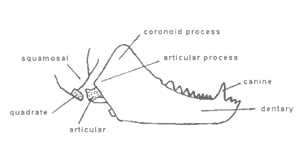Is there anything on television worth watching? Maybe.
Who has the most dangerous job in prime-time TV and at the movies? Police officers? Soldiers? Private detectives? None of the above, according to one survey of occupational groups in entertainment – it’s scientists who are mad, bad and dangerous to know.
In a survey taken in 1987, broadcast critic George Gerbner found some disturbing tendencies in our on-screen scientists. At that time, ten per cent of scientists featured in prime-time television entertainment got killed and five per cent killed someone. Take horror films, and scientists are second only to psychotics as the primary troublemakers, and apparently cause more problems than zombies, werewolves and mummies combined.
I’m concerned with the image of scientists here because they are usually the only ones who show any glimmer of critical thinking, however misguided.
For the last fifty years or so it has been the role of the skeptic and the scientist to act as the fall guys. They’re the ones who are too busy scoffing to notice the werewolf creeping up on them, the alien aiming a death ray, the dinosaur in the rear vision mirror. And it’s their hubris which tends to cause disaster to befall their companions, if not imperil life on Earth itself.
The plotlines have followed the same formula since the 1950s:
Take one scientist with an obsession.
Add some radiation, lightning, spare body parts or somesuch and you’ve got a monstrous menacing creation.
Said creation escapes or goes out of control, often with the assistance, unwitting or otherwise of the deformed or aged assistant.
Enter the potential victims, usually children – or a young couple, if you need a love interest. They often try to warn people about the threat, setting up the skeptical unbeliever for body snatching, disembowelment or demon possession.
But eventually these innocents save the day, often with the assistance of the local police, military, villagers with burning torches etc.
The Good Old Days
At least during the 50s, when mad scientists were busy unleashing all manner of Things, blobs, giant tarantulas, flying piranhas, killer tomatoes and other horrors on the planet, there were some good scientists who were able to figure out ways of dealing with the critters.
These days scientists can’t even do that. Instead they’re usually presented as either incompetent fall guys who have to be outwitted by benign laypeople, or evil amoralists willing to do anything in the name of science.
I’m not sure whether I feel reassured or not by the latest take on Frankenstein. Speaking of his recent movie version, Kenneth Branagh said that he wanted Victor Frankenstein to be seen, “not as a mad scientist but as a dangerously sane one”.
But perhaps we’re being too precious. After all, to paraphrase Michael Crichton, everyone gets short shrift in the movies – politicians are invariably corrupt, businessmen are crooks, lawyers are unscrupulous. It’s part of telling a story – you have to have heroes and villains, and most general-release movies demand simple plots and cardboard characterisation.
Part of the problem is that skepticism can get in the way of a good story. Who wants to hear about an old house that isn’t haunted (see page 18)? Or a dinosaur park where they design decent containment systems? Where’s the entertainment in that?
Yet all is not lost. There have been some wonderful moments of film footage which could be considered dear to a skeptical heart.
Cold reading is an important skill for any self-respecting psychic – using those valuable clues of context, body language and the general similarity of people to reflect back to them their hopes and fears.
The classic “Wizard of Oz” has a great example of this, and one of my favourites as it doesn’t take a genius to figure out what’s going on when Dorothy is running away from home and meets the fortune-telling professor. In case his quick glance at her suitcase is too subtle, he goes on to rifle her basket in a well-intentioned search for clues that he can turn into a psychic reading which will turn Dorothy’s footsteps home.
A more sophisticated version can be seen in the fun Steve Martin film “Leap of Faith”. Here he plays Jonas Nightingale, the head of a travelling preacher show, complete with convoy, choir and all the razamatazz of the circus.
It opens with him doing a cold reading on a cop who has stopped his convoy for speeding, picking up on all sorts of clues to get out of a ticket. There’s nothing subtle about this – just before he gets off the bus, where his crew are laying bets on his ability, one of the newcomers asks plaintively “what’s a cold reading?”.
Nightingale goes on later to wow the locals of a small town with his miraculous abilities to know their troubles, utilising old-fashioned eavesdropping and the technological support of a good database and radio communications. It’s a great movie based in part on the real-life cons run by US preachers like Peter Popoff.
Human nature
Of course it seems to be a part of human nature to want to believe, and that’s what these sorts of preachers, psychics and snake-oil salesmen take advantage of. Disney’s “Pete’s Dragon” has a great demonstration of where the desire to believe overpowers initial skepticism, helped along with a little show biz, as the good people of Passamaquoddy are convinced to forget their bad experiences in the past with two dubious characters and sign up for their latest nostrums.
I can reveal that the snake oil salesmen come to a bad end, albeit a comic one (this is Disney after all).
Ironically, in looking for positive images of skepticism, the bulk of the ones I have come across have been in children’s programmes.
Scooby Doo Where Are You?
Many of us have grown up with the derring-do of Scooby Doo, but I hadn’t thought hard about the storylines in this long-running cartoon series until a couple of years ago. The storyline is fairly constant – some kind of ghost or werewolf or Bigfoot or other paranormal phenomenon scares the Scooby Doo team until at the last it’s revealed to be a hoax.
I do wonder if they hadn’t a closet skeptic in the scriptwriting department. Sadly, the thing which jogged my memory of this was a cri de coeur from a poor skeptic, Tim Madigan, who wailed that the most recent movie had sold out.
“No longer do the intrepid investigators prove that the paranormal is all a ruse. In their latest incarnation, Daphne is now a TV reporter for an Entertainment Tonight-type show. She goes to New Orleans to look into reported hauntings, bringing her old friends along. She and the other members are once again beset by a ghost of a pirate, as well as assorted zombies, werewolves and vampires. But this time, when Fred and Velma present possible rational explanations for the weird events, they are pooh-poohed by Daphne, who goes so far as to tell Fred “you’re not a skeptic, you’re in denial.”
As Tim goes on to say, “it’s all such a sad betrayal of the original show’s glorious skeptical tradition.”
Perhaps there’s hope in other cartoon shows – my kids are addicted to the “Magic Schoolbus” series, which focuses on teaching science. I think they killed two birds with one stone in a recent show covering the concepts of buoyancy and pressure, while revealing the media-inspired hoax behind a would-be Loch Ness monster.
Another nice thing about the Magic Schoolbus is that each episode ends with kids critically questioning what’s shown – the Magic School bus can’t really grow fins and go under water – and the show producers explaining where they have taken liberties and why.
Larry Zimmerman, an anthropology lecturer at the University of Iowa, gets his students to think critically about documentaries like “In Search of Ancient Astronauts” and “UFOs; The First Encounter” and “The Mysterious Origins of Man” to critically examine how evidence is presented and what techniques are used to try and make cult archaeology and creationism credible.
Handy Questions
The questions are handy ones to bear in mind should you find your nearest and dearest riveted by the wisdom of that famous Old Testament researcher Charlton Heston. Things like:
Why do you suppose that certain sites or evidence always seems to show up in these videos?
What clues are there that some of the segments are used out of context?
How is the choice of narrator used to boost the credibility of the video?
You don’t have to be a Stage One anthropology student to get something out of a discussion along these lines. I’ve had similar conversations with my eight and 6-year-old about things they see on TV.
Of course, it does help to know what they are viewing.
A popular phenomenon of recent years has been Pokemon, some 150 horribly over-commercialised little creatures brought to your television screens courtesy of Japanese game company Nintendo.
For those of you who have had to endure seeing your children or grandchildren addicted to collecting Pokemon games, trading cards, models, t-shirts and all the other paraphernalia of fandom, I can now reveal that all has not necessarily been in vain.
One of the premises of the Pokemon world is that these cute wee things evolve. They adapt to their environment, with the fittest surviving and dominant traits coming to the fore. It’s not strictly Darwinian but there’s enough evolution there to offend Southern Baptists and Saudi Arabian muftis alike, both of whom have censured the programme for introducing the word “evolution” to 5-year-olds.
In this day and age things tend to move very fast, so you might say that Pokemon demonstrate an accelerated form of punctuated equilibrium at an individual level. That is, each individual Pokemon evolves into a different form.
One such Pokemon is called Abra. The Pokemon website notes that though it is psychic, it lacks any useful abilities except for the ability to teleport out of trouble.

Now bearing in mind that this Pokemon is called Abra, would anyone care to hazard a guess what the evolved form might be? Kadabra – right!
Again, according to the stilted English on the website, Kadabra “doesn’t have a powerful body, but relies on a strong mind to win. It can send out waves of mental energy that cause headaches at close range.”
In addition to a mental attack, this Pokemon sports a rather surprising weapon. Not exactly an M16, but something no self-respecting psychic Pokemon would be seen without, it appears….Yes, it carries a bent spoon…

When Kadabra evolves into yet another higher life form, his weaponry increases, and he becomes known as Alakazam…

Now you mightn’t take this very seriously, but Uri Geller has been spitting tacks over this utensil-wielding creature and has filed suit against Nintendo for $100 million. Apparently when he visited Japan he was mobbed by people wanting his autograph on their Pokemon trading cards. Of course, it didn’t help that in Japan, Kadabra is known as Un Geller…
“Nintendo turned me into an evil, occult Pokemon character,” Geller complained. “Nintendo stole my identity by using my name and my signature image of a bent spoon.”
My heart bleeds…It was quite interesting seeing the response of the Pokemon fans to this news. Many of them had never heard of Geller – hardly surprising as the bulk of fans are under 15, but the chat rooms and news announcements variously described Geller as:
a “self-proclaimed psychic and magician”,
an “internationally renowned con artist”
and an “all-around creepy guy”
One particularly perceptive and indignant young fan remarked “if Geller really is psychic, how come he didn’t know there was a Pokemon based on him out already before he saw the card?”
I sometimes wonder if our so-called innocent credulous children are actually the most skeptical of us all, and that we lose this as we get older. Maybe there’s something in the hormones which confers an evolutionary advantage to gullibility.
In “Secrets of the Super Psychics”, skeptical researchers Dr Richard Wiseman has a group of adults jumping out of their seats when glowing objects start to move and float above a table in a dark séance room. What they can’t see (and we can, thanks to the right film) is that these things are being moved by the alleged psychic and an assistant, cloaked by the darkness.
Although programmes like “Secrets of the Super Psychics” are far outnumbered by the plethora of “unsolved mysteries, “believe it or not” and “in search of..” efforts, I think that few people will forget Richard Wiseman’s séance set-up once seen, and they may well be more critical if ever encountering that particular scam in the future.
At least I’d like to think that.
We’ve argued for many years back and forth about whether something as straightforward as violence on television actually affects people. How are we to determine the far more tricky question of television’s role in producing a gullible society?
It may not come as a complete surprise that there appears to be a correlation between television viewing and levels of credulity. Those addicted to “Oprah”, “The X Files”, the “Holmes” show, reality television and other areas considered entertaining viewing are more likely than infrequent viewers to hold negative views on science and positive ones towards the paranormal or pseudoscience.
They’re more likely to believe in astrology and think it scientific; more likely to think science dangerous; more likely to consider scientists as odd and peculiar.
This is not a simple expression of education levels, age, gender or any of the other factors likely to influence attitudes, as the study which produced these findings took those into account and still demonstrated that TV fans think scientists are mad, bad and dangerous to know.
Communications professor William Evans has argued that increasingly, film and television entertainment portrays science as useless in solving problems. It is seen as a handicap to use reason and to think skeptically.
Skepticism is all too-often used as a synonym for closed-mindedness. Take Agent Scully in “The X Files” – any self-respecting skeptical scientist confronted with quite that much unequivocal evidence for paranormal events would just have to stop and wonder. If I was her, I’d be off to get James Randi’s one-million-dollar prize like a shot.
One could argue that there isn’t necessarily a direct causal relationship between what is shown on the screen and the poor image of skepticism and of science, but I think it’s safe to say that television and film provide a welcoming environment for the paranormal and pseudo-science. It gets far more sympathetic coverage, with little in the way of challenge, than that of science in general.
We had a psychic story in the Christchurch Press a few weeks ago. A psychic in Ashburton had managed to find not one, but two missing dogs. The first, lost on a farm, was predicted to be found somewhere near water; the second, apparently lost on a hiking trail, was divined as likely to be found near a tree. And you know what? He was right! Astonishing stuff.
This was considered sufficiently newsworthy to be given two columns and a photo in the Press; TVNZ went one better and sent a film crew down to Ashburton and then out to see me. All I can say is it must have been a very slow news day…see film at 10…
My thanks to Graham Hill and Alastair Brickell for their information, suggestions and videos.
Some Videos of Note
- Leap of Faith
- The Magic Schoolbus
- Pete’s Dragon
- Scooby Doo
- Secrets of the Super Psychics
- Wizard of Oz
Interesting Articles
- Science and Reason in Film and Television
- William Evans, Skeptical Inquirer, Jan/Feb 1996 http://www.csicop.org/si/9601/media.html
- Screening DNA Exploring the Cinema-Genetics Interface
Stephen Nottingham, 1999 - http://ourworld.compuserve.com/homepages/Stephen_Nottingham/DNAIntro.htm
- The X-Files: Entertainment, Science and Skepticism
Fredric L. Rice - http://www.skeptictank.org/xfiles.htm
- Lost Tribes, Sunken Continents and Ancient Astronauts: “Cult” Archaeology & Creationism Anthropology Seminar
Larry Zimmerman, University of Iowa - http://www.uiowa.edu/~anthro/webcourse/lost/videos.html



